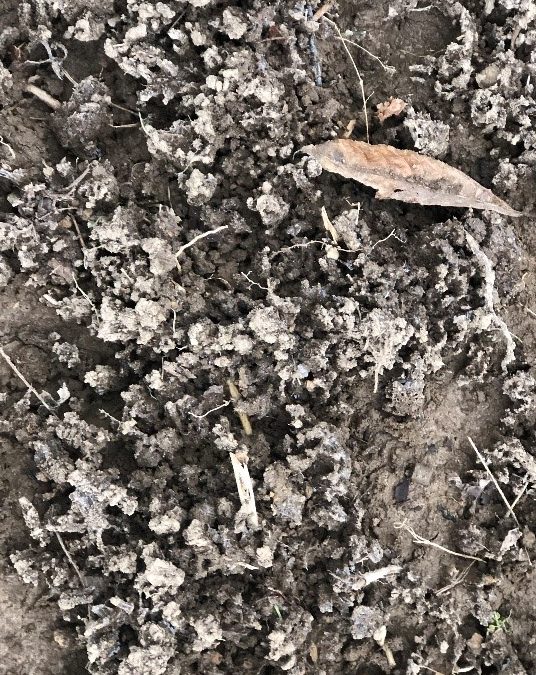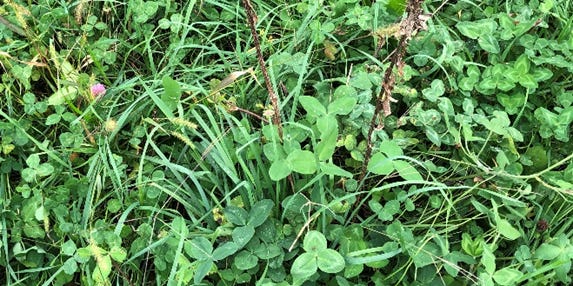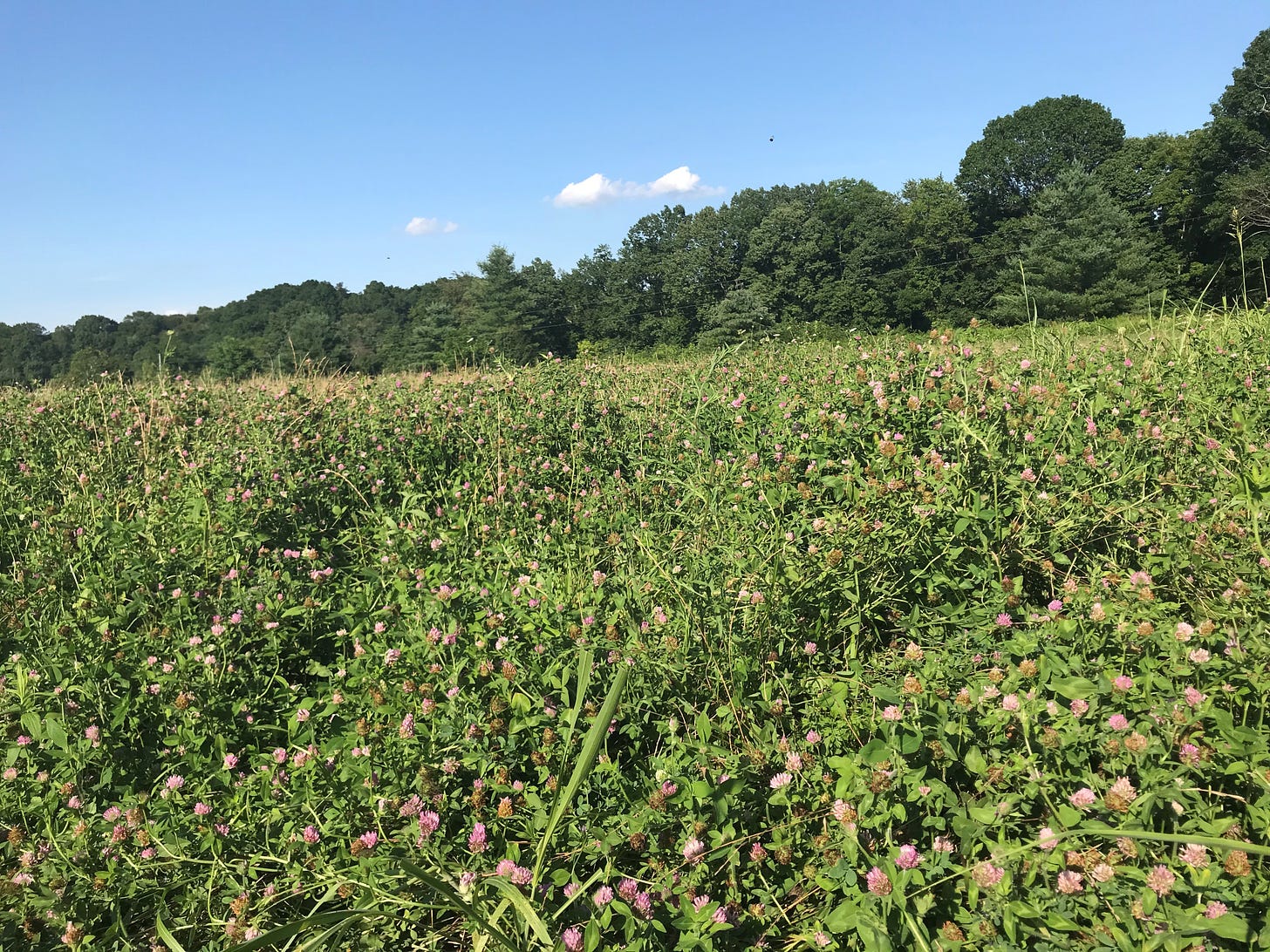
Frost Seeding Legumes
When it comes to frost seeding, all you need is a good honeycomb freeze (a shown in the above photo) and an electric seeder on a 4-wheeler. This cold snap we’re experiencing is a perfect time for frost seeding. A layer of snow will help you to see your tracks and seed distribution.
There are times when frost seeding might not be necessary. If you maintained thick residual (intact plants 2” or taller) and residue (detached cover, mulch) all the pasture usually needs is recovery time. Also, if you are a top third grazer it’s going to be hard to maintain legumes due to shading them out, so why seed them?
What fields should be seeded? Fields that have some exposed soil are the best candidates for frost seeding. If you plan on feeding hay in those pastures this winter, just wait until March to reduce excess trampling. Unrolling hay can be beneficial after seeding as long as it doesn’t cause serious mud outs.
Frost seeding round seeds like legumes and brassicas works well with this treatment. Their shape and weight pull them into the ground for good contact and better germination. I typically add 5 pounds of grass seed with the legumes and brassicas in order to thicken the stand.
What should you frost seed? Consider your existing fertility when deciding which species to seed. The standard recommendation is “2,4,8 let’s renovate” coined by the late Dr. Joe Burns, University of TN Forage Specialist. That translates to 2 pounds of white clover, 4 pounds of red clover, and 8 pounds of annual lespedeza. Ideally, your soil should have a pH of 6.2 or higher at seeding and have a moderate to high level of Phosphorus and Potassium.
Matching seeds with conditions will save time and money so it’s important to understand what each type of plant needs in order to thrive.
All white clovers, with the exception of the lower growing shouldn’t be sown unless fertility is high.
When it comes to deciding what varieties to plant, I like to look at variety trials and compare them to see what will work best in each situation. Typically, you won’t find big differences between varieties but how you manage your grazing heights and recovery times have the greatest influence on production and longevity.
White Clover: The larger leaf and upright habit of the Ladino white clovers make them good forage types. Although Dutch types tend towards a more prostrate plant, these long-lived varieties tend to produce a lower yield. They are also better adapted to lower fertility then other white clovers. Intermediate types like Patriot, Durana, and Resolute fall somewhere in between Dutch and Ladino types and are more aggressive.
A bermudagrass/legume mix makes a good stand when seeded into the bermudagrass in the fall, about 20 days prior to the predicted killing frost.
Red clover, a biennial typically lasting two winters can produce an extra year of production when sown in February or drilled in March. Certified Red Clover seed can last three winters and allowing some seed set in the summer will increase the longevity of the stand by reseeding. Some varieties I seed are: Certified Kenland, Cinnamon, or 401RC.
Annual lespedeza is very well adapted to low fertility, low producing, and shady fields. If given ample recovery time in early September, this annual will reseed. Kobe is preferred for pastures and Korean for hay but the two are typically found in a mix. Marion is one well known variety that tends to reseed better than other varieties. The price of lespedeza varies widely from year to year so I’ll usually seed less per acre or won’t seed it at all if it’s higher than $1.50 per pound.
Brassicas are annuals and good indicator plants. They perform best where organic matter and soil fertility is good. Yellowing and poor performance are telltale signs of poor soil fertility. Brassicas are often sown in the fall but a spring seeding can work very well with good survival through next spring.
Forage radishes are best known for their long tap root and for reducing the effects of compaction. Both tap and fibrous roots help to reduce compaction which usually occurs at three to five inches. Longer recovery periods increase roots and decrease compaction. Tillage exacerbates compaction issues.
Forage radishes and turnips are best seeded at less than 2 lbs/ac. I typically seed one pound per acre
Spring pugging (hoof imprints in the field) benefits from a seeding of a grass/legume mixture. KY 31 contains endophytes and reduces animal performance but it’s a tough grass that holds up better to traffic and short grazing.
For years, I have seeded improved grasses along with legumes and brassicas on my hay feeding areas but I have concluded that especially where hay rolls have been set across the fields, KY 31 is the best choice. I have found that no matter what grass is seeded, the livestock graze the tender new seedlings more than well-established grasses and KY 31 can hold up better.
Orchardgrass and Persister bromegrass are tolerant of shading and do well in mixes. A good stand of annual ryegrass is almost guaranteed but can be very competitive with legumes and perennial grasses. I don’t recommend adding more than 1 lb per acre. I usually recommend adding spring oats at a rate of less than 20 lb/ac with the legumes.
If seeding in March, it’s best to use a no-till drill or light tillage to get seed soil contact. A cultipacker behind the seeding is ideal. Another option is to wait till May and seed a warm season annual like Sudangrass on feeding areas.
All that said, if cost is an issue, seed lower rates, half rates work well if you have good seeding conditions. I do not like to spend more than $35/acre on seed.
Cost effectiveness: The clover should produce fifty or more pounds of Nitrogen/ac. At $0.40/lb of N an annual return of $20 is typical and if your stand lasts three years, that’s $60/ac.
Why Should you invest in Frost Seeding?
Animal gains per acre should increase easily by 0.2 lb/day or $45/ cow/calf per year. Milk production, body condition. and conception rates should also improve. So, a conservative return is $65 per acre/yr plus increased conception rates and improved soil health.
Management of legume seeding
It’s best to not fertilize with nitrogen the same season that legumes are seeded as it stimulates grass growth, thereby shading out the legumes. If phosphorus is low, it’s best to use something like a low N 11-52-0 (MAP). Keeping light to the newly seeded legumes will be important for survival rates. Managed grazing and/or clipping will endure a good stand.
Wishing you the best, if you have questions, concerns or rebuttals about anything I have presented, feel free to respond to me at gregbrann5@gmail.com. There are many ways to accomplish regenerative grazing.
EVENTS
October 14, 2021 Big Spring Farm Pasture Walk
May 6-8, 2021 Greg Judy Grazing School – SOLD OUT
November 5, 2021, TNFG Conference, http://utbfc.utk.edu/

